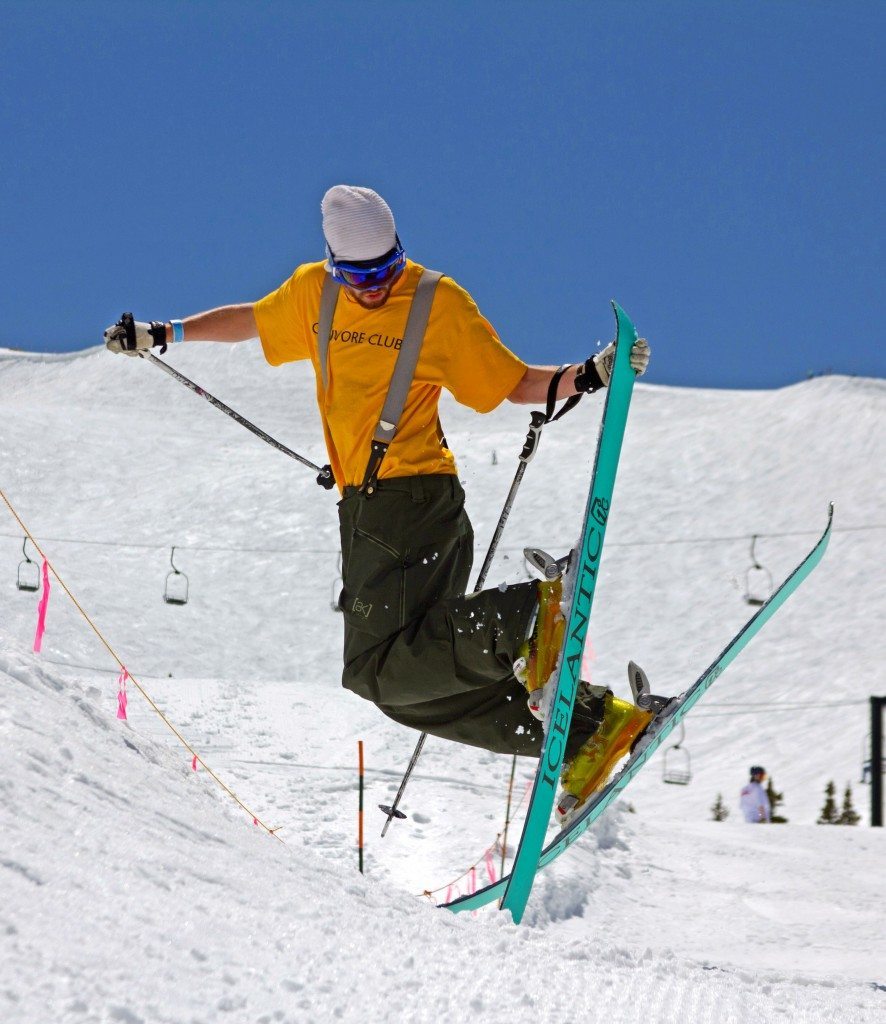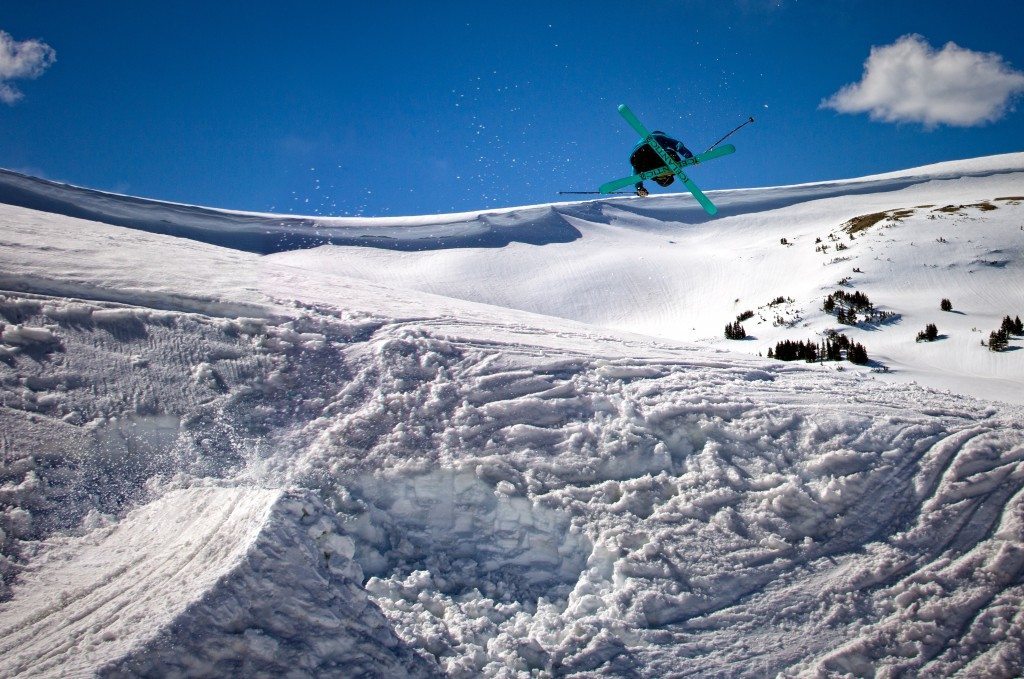
Ski: 2013-2014 Icelantic Da’Nollie, 180cm
Dimensions (mm): 118-88-118
Turn Radius: 20 meters
Actual tip to tail length: 177.2 cm
Boots / Bindings: Nordica Supercharger Ignition / Marker Griffon, DIN (10)
Mount Location: Core Center
Test Location: Arapahoe Basin
Days Skied: 2
[Editor’s Note: Our review was conducted on the 11/12 Da’Nollie, which is unchanged for 12/13 and 13/14, except for the graphics.]
You may know Icelantic because of their fresh graphics and unusual designs, like the relatively short Shaman with that enormous shovel.
The 11/12 Icelantic Da’Nollie, however, is nothing revolutionary design-wise as far as park skis go; but it’s just about as good as park skis come.
When I arrived at A-Basin for what would be my first day on the Da’Nollie, I was still recovering from the previous day’s bluegrass festival and end of the year party. Needless to say, I was a little low on energy that first day. My first run on the Da’Nollie, however, snapped me out of my morning stupor, and I quickly learned that the Da’Nollie is a very lively and playful ski. I took a few laps on Black Mountain Express while I waited for the rest of the BLISTER crew to get ready, and I was immediately impressed. I found the Da’Nollie to be very quick from edge to edge, and it felt lively when carving – responding well to my every move.
Even with traditional camber and freshly tuned edges, I found the Da’Nollie to be easy to pivot. I had a blast slashing the slushy bumps that were beginning to build on High Noon and Sundance. As Will Brown mentions in his review, these characteristics make the Da’Nollie a good performer in the bumps despite its longer tail.
What really impressed me initially was just how well the Da’Nollie skied switch. When I hopped backward after getting off the first lift, the Da’Nollie handled so well that I opted to ski all of High Noon switch. Weaving in and out of slower traffic, I had never felt so in control. Of course, lots of center-mounted park skis do switch well, but the Da’Nollie’s solid flex and moderate turn radius definitely bumped up its switch performance. After skiing this and other symmetrical skis, I am convinced that a symmetrical shape is the only way to go if you will be spending a good portion of your day facing uphill.
Despite the ski’s solid flex underfoot, a slightly more forgiving flex towards the tips made butters, presses, and nose blocks a snap. My own park ski, the K2 Kung Fujas, is comparatively easy to flex, but it does not respond as well when popping butters. I preferred how the Da’Nollie pushed back when I pushed on it. The Da’Nollie’s flex and shape made it tons of fun to nollie, butter, and press onto the rails of the High Divide and Treeline terrain parks. Compared to the softer skis that I had used on rails before, (the Line Invader, K2 Kung Fujas, etc.) the Da’Nollie was more stable and in control, probably due to its 88mm waist, symmetrical shape, and center mount position.

I didn’t find the Da’Nollie to be particularly light (as Will had), and I thought the swing weight of the Da’Nollie was fairly average for a park ski. This is not to say that it was hard to coax the Da’Nollie to switch up on one of Arapahoe Basin’s double barrel rails. It felt like I had a nice amount of ski under my feet, which I prefer to swinging chop sticks around. This ski is light – but not too light – giving it the beef to hold its own all around the mountain.
The Da’Nollie’s poppy nature, carvability, wider dimensions, and manageable swing weight made it a joy to play with. I felt comfortable and in control when carving into natural and man-made features, and I was able to get more pop on the Da’Nollie than I do with my now flat cambered K2 Kung Fujas (flat due to abuse, not design) and other softer or rockered park skis.
While sessioning a kicker we built in the afternoon of the first day, I had a blast playing cowboy with the Da’Nollie. Despite my low energy reserves (I was really dying at this point in the day), I was easily able to throw rodeo 5s and 7s off of the step up. The ski’s wide profile, moderate swing weight, and stiff, poppy flex made negotiating the in-run, setting the trick, grabbing my skis, and stomping the trick a breeze. I didn’t get the chance to test the Da’Nollie on large park jumps, but given my experience with the ski at speed and on decent sized natural airs, I would expect the Da’Nollie to do just fine. (Leigh Powis, at least, seems to like them well enough when he’s tossing triples.)

The Da’Nollie also performed admirably beyond the park and backcountry kickers. My second day on the Da’Nollie, I sent a 3 off King’s Cornice to a flat landing of a foot of heavy chop. The ski pulled out just fine and performed surprisingly well in the 2:00pm mash that was present between the cornice and the Treeline Park. With its stiff, responsive flex, the Da’Nollie was able to plow through murk, take fast airs, and maneuver quickly for a park ski. (It should be said that, having grown up in Juneau, AK, and skiing “sierra cement on steroids” all the time, everyone might not have the same experience as me in this kind of snow with the Da’Nollie. )
The Da’Nollie doesn’t have the status of some park skis like the Armada AR6, but it should. Icelantic has created a spot-on park ski at a time when many companies are tinkering around with their skis from year to year. If you love to ski switch, like butter on more than just your toast, primarily ride park, and occasionally take your skis off-piste, the Da’Nollie might just be the perfect ski for you.

If i was gonna get these skis and have to ride them for about a year and a half, do you think the skis would hold up enough to not have to buy new ones next year.